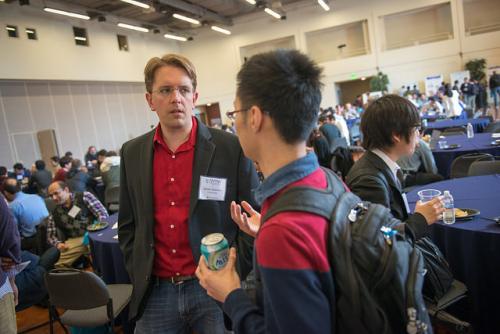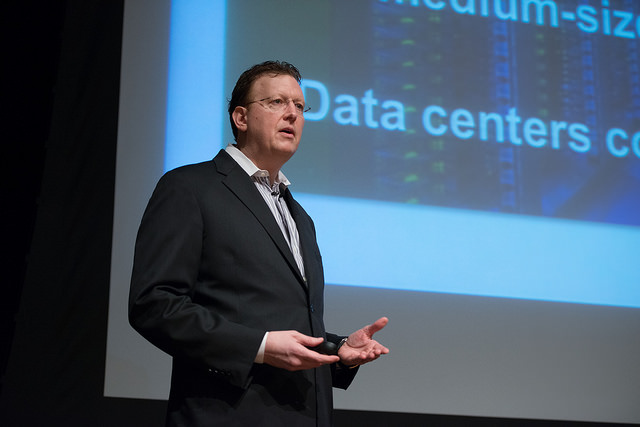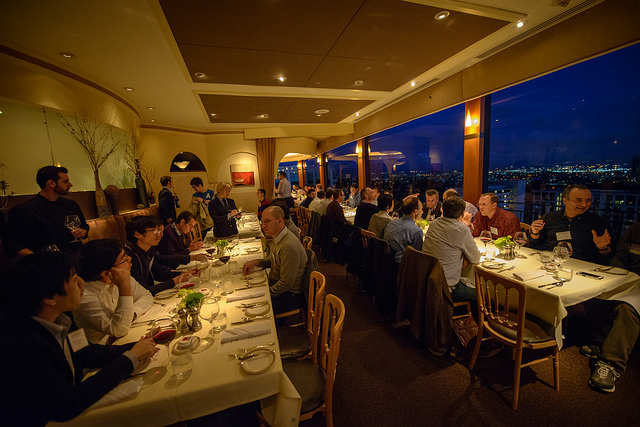
 Industry, Academic Experts Flock to Annual Non-Volatile Memories Workshop
Industry, Academic Experts Flock to Annual Non-Volatile Memories Workshop
Approximately 220 researchers from academic, industry and national labs were at UC San Diego in early March for the sixth annual Non-Volatile Memories Workshop. The annual event is co-organized by CSE’s Non-Volatile Systems Laboratory, Calit2’s Qualcomm Institute, and the Center for Magnetic Recording Research (CMRR). It took place in the Price Center March 1-3, culminating in a banquet at Mister A’s overlooking a dramatic downtown skyline. [Click here to view photos from the workshop and banquet]
The workshop brought together scientists and engineers working on advanced, non-volatile storage devices and systems. “We expanded the program this year to reflect the strong set of submitted papers we received,” said CSE Prof. Steven Swanson (at right, with student), who co-founded the annual workshop and co-organized the 2015 event with ECE Prof. (and former CMRR director) Paul Siegel and Technion’s Eitan Yaakobi. “It’s been very exciting to see the community expand to tackle the wide range of challenges that non-volatile memories present. You can really see the evolution in the problems people are addressing.
 “As a community we have tackled many of the ‘low-hanging fruit’ and we are moving onto deeper, more interesting and more challenging problems,” he added.
“As a community we have tackled many of the ‘low-hanging fruit’ and we are moving onto deeper, more interesting and more challenging problems,” he added.
According to Swanson, high points of the 2015 NVM Workshop included industry participation in the form of keynote presentations by top people from Samsung, Intel and Seagate.
Samsung senior vice-president Bob Brennan (at left), who leads the company’s Memory Solution Lab, addressed the conference on “How NAND-based Technology is Transforming the Data Center.”
The March 2 afternoon speaker was Phil Brace, Executive VP of Electronic Solutions at Seagate Technology. His topic: “Storage – Moving Towards Tailored Solutions.”
Then Intel’s Andy Rudoff opened the final day of the workshop, with the Principal Engineer musing on the subject, “In a World with Persistent Memory…”
In addition to the industry keynotes and a half-day tutorial March 1 on the RAMCloud Storage System, the two parallel conference tracks packed more than 40 paper presentations by researchers from around the world – a substantial number of them working in industry, including at HP Labs, Sandisk, HGST San Jose Research Center, IBM Research in Zurich, Intel and Samsung.
 Ahead of the 2015 meeting, Prof. Swanson was interviewed in the February issue of ;login:, the USENIX magazine, on the future of non-volatile memories and storage. He told editor Rik Farrow how he got interested in the field as flash memory began to take hold in industry. “It turned out to be a perfect research problem for me,” said Swanson. “It involved hardware and system design (which is, broadly what I did my PhD on), and it centered around a huge disruption in the performance of a particular piece of the system… My students and I dove in, and it’s been really exciting and has allowed us to do interesting work on both the hardware and software side as well as at the application level.”
Ahead of the 2015 meeting, Prof. Swanson was interviewed in the February issue of ;login:, the USENIX magazine, on the future of non-volatile memories and storage. He told editor Rik Farrow how he got interested in the field as flash memory began to take hold in industry. “It turned out to be a perfect research problem for me,” said Swanson. “It involved hardware and system design (which is, broadly what I did my PhD on), and it centered around a huge disruption in the performance of a particular piece of the system… My students and I dove in, and it’s been really exciting and has allowed us to do interesting work on both the hardware and software side as well as at the application level.”
While much of the ;login: interview is focused on a history of NVM, Swanson also talked about the future. He noted that a likely early application for NVM is in smartphones and other mobile devices. “You can imagine a system with a single kind of memory that would serve the role of modern DRAM and also serve as persistent data storage,” said Swanson. “Since it would have the performance of DRAM, it could alter the programming model for apps… they could just create data structures in persistent memory… a nice fit for lots of small, one-off apps.”
Learn more about the Non-Volatile Memories Workshop.
Read the full USENIX ;login: interview with Stephen Swanson.

